Here is a pretty cool article on recording hand percussion. By “hand percussion,” this article means things like tambourines and shakes. They talk about different types of mics you can use, different ways to use those mics, how far to get from the mic, etc. Adding these sounds to your music recordings can really give it them that certain extra something that turns an OK mix into a really good one.
They even have a video in the article to help demonstrate their tips.
Check it out here: http://www.prosoundweb.com/article/in_the_studio_hand_percussion_recording_tips_includes_video/?utm_source=feedburner&utm_medium=feed#When:16:10:49Z
How To Quickly and Accurately Cut, Copy or Paste Parts of a Song
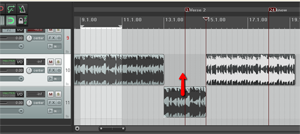 Whether you are recording your own music or working with a music file that already exists (usually a royalty free music clip for background music), there are many times when it is useful to cut, copy, and maybe paste sections of a song. Here are just a few of the more common reasons for needing to do that, just off the top of my head:
Whether you are recording your own music or working with a music file that already exists (usually a royalty free music clip for background music), there are many times when it is useful to cut, copy, and maybe paste sections of a song. Here are just a few of the more common reasons for needing to do that, just off the top of my head:
- Shorten or lengthen a song to make it fit a presentation, video or voice-over production
- Building a song by copying repetitive sections (entire bars or sets of bars) and pasting them
- Fixing a problem in a song you are recording (for me it’s usually guitar buzzing I use this for) by clipping the same chunk of music from another part of the song and replacing the problem section.
 When working with music files, it is important that any edits you make do not mess with the timing. Otherwise it will be jarring to the listener. If you want to slice up a song, say, to make it fit a video, you want it to sound seamless in terms of the beat of the song. One excellent tool for doing this is the snap tool. This is a pretty common tool for editing both audio and video. In the picture on the left is where to find the tool in Reaper.
When working with music files, it is important that any edits you make do not mess with the timing. Otherwise it will be jarring to the listener. If you want to slice up a song, say, to make it fit a video, you want it to sound seamless in terms of the beat of the song. One excellent tool for doing this is the snap tool. This is a pretty common tool for editing both audio and video. In the picture on the left is where to find the tool in Reaper.
Snap To
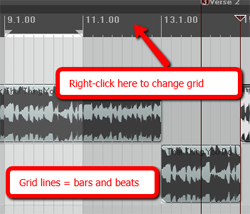 The idea of snapping is simple enough. It is a way to ensure the edges of an item can only be be moved and placed so that they align with a grid. In the case of audio, that grid is frequently bars and beats, though you can change the grid to be other things, like minutes and seconds, etc. For our purposes in this article, we want to make sure we use bars and beats. In Reaper (see picture on the left), simply right-mouse click in the band across the top of the screen to change the grid settings.
The idea of snapping is simple enough. It is a way to ensure the edges of an item can only be be moved and placed so that they align with a grid. In the case of audio, that grid is frequently bars and beats, though you can change the grid to be other things, like minutes and seconds, etc. For our purposes in this article, we want to make sure we use bars and beats. In Reaper (see picture on the left), simply right-mouse click in the band across the top of the screen to change the grid settings.
The next important thing is ensure the song is aligned with that grid. When you’re recording your own music, this is not an issue as long as you are recording to the metronome which you set in the song project settings. And I HIGHLY recommend that you do that if at all possible. It makes things much easier in the long run.
If you have imported a song already recorded, you will have to do a few things to get its beats on the grid of the audio software. You’ll have to do a little trial and error, first setting the correct time signature for the song, then using the metronome and experimenting with the beats-per-minute setting until the song matches. Ironically, you’ll want to make sure the snap tool is turned off while you do this, so you can freely drag the song on the track to line up the visible beats to the grid.
Fixing Example
Once the song is matched to the grid, you’re free to copy, cut and/or paste and have the result be musically correct. Let’s take an example of when you need to correct a mess-up in the middle of your song (like my guitar buzz).
1. Just go to another part of the song with the same guitar chord playing without a buzz, and select the beat or beats containing that section. Make absolutely certain that the snap tool is turned ON when you do this.
2. Next, you click in the selected section and right-mouse-click to open the drop-down menu and select “copy selected area of item.”
3. Now open a blank track underneath the song track (you can see this in action in the picture at the top left of the article). This isn’t strictly necessary, but I find it helps to line things up BEFORE pasting into the song, which can save you lots of time and headaches. Paste the bit you copied into the blank track right underneath the buzzing guitar part. You may have to drag it left or right to m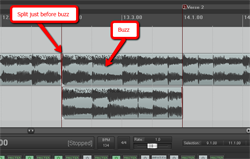 ake sure you line it up just right. Again, the snap tool needs to be ON at this point.
ake sure you line it up just right. Again, the snap tool needs to be ON at this point.
4. Next, click on the song at the beginning of the beat that has the guitar buzz and hit the “S” key on your keyboard to insert a split in the song file.
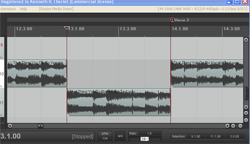 5. Now drag the left edge of the section with the guitar buzz in it to the right, creating a blank space where you will insert the part you are pasting. Things should now look like the picture to the left.
5. Now drag the left edge of the section with the guitar buzz in it to the right, creating a blank space where you will insert the part you are pasting. Things should now look like the picture to the left.
6. Now all you have to do is drag the pasted bit from the audio you pasted in the spare track up into the blank space. Having the snap tool on will ensure it doesn’t slip or slide to either side when doing this, which is a common problem when you don’t have snapping enabled.
7. The final step here is to make sure things sound smooth and seamless. Turn the snapping tool off (yes, OFF) and drag the edges of the new part you just pasted in a little left and right. Since cross-fading is turned on automatically in Reaper, this will allow the sounds to blend a little more smoothly. Otherwise the abrupt implanting of a different section might sound a bit jarring, creating clicks or pops at the borders. Cross-fading will help eliminate that problem.
And that’s it! It may sound a bit involved, but the entire process only takes about 30 seconds, which is usually a lot faster than having to play the part again.
Now you can use the same steps to remove parts from a song. Just select (with snapping turned ON) the part you want gone, hit the delete button on your keyboard and it’s gone. Now you can drag the part on the right back to join up with the song part on the left (closing the hole in the audio). Of course, if you had ripple-editing turned on, the part on the right would automatically be pulled to the left to join the two parts up.
If you want to make a song longer, just select a part of the song you want to repeat, usually a full measure, and paste it at the end of the song. Do this as many times as you need to in order to make the song as long as you need it to be.
Hopefully this simple tip of using the snap tool will help you cut, copy and paste bits of songs to your heart’s content.
The New IK Multimedia iKlip Studio iPad Stand
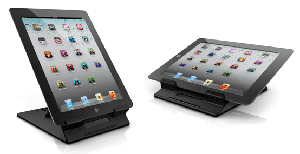 IK Multimedia, maker of cool music tools to iOS in addition to their awesome software line, just announced the release of another practical tool – the iKlip Studio. This is a stand for the iPad that sets on a horizontal surface like a table or desk. This is the 3rd in their “iKlip” series. The original iKlip was to allow you to attach your iPad to a microphone stand, which is cool for reading lyrics or scrips, as well as using it on stage for controlling any number of live performance tools for iOS. Next came the iKlip mini, which is the same thing as the iKlip except it’s for the iPhone or iPod touch.
IK Multimedia, maker of cool music tools to iOS in addition to their awesome software line, just announced the release of another practical tool – the iKlip Studio. This is a stand for the iPad that sets on a horizontal surface like a table or desk. This is the 3rd in their “iKlip” series. The original iKlip was to allow you to attach your iPad to a microphone stand, which is cool for reading lyrics or scrips, as well as using it on stage for controlling any number of live performance tools for iOS. Next came the iKlip mini, which is the same thing as the iKlip except it’s for the iPhone or iPod touch.
The iKlip Studio is different in that it isn’t for a mic stand but instead designed to prop your iPad up while sitting on a table or desk. This is especially useful when using the iPad music apps that require you to do a lot of tapping and stabbing, like beat-pads, synthesizers or other controllers. The stand will adjust to whatever angle you need while still allowing a firm hold and a bit of give simultaneously. It has rubber feet to grip the surface it sits on. It also has a support tray that will fit an iPad of any generation.
It sounds simple but it really is a blessing. If your workstation has a fairly high desk, having to do a lot of work on a totally flat surface can be a huge pain. In fact sometimes, as in the case of one keyboard I’ve worked with, it often requires me to stand up just so I can see the displays. I REALLY wish there were a stand like this for that particular device. Oh well. You can’t have everything.
This thing will be $29.99 and will be available, according to IK Multimedia, in Q1 2012. AS I mentioned earlier, pre-orders are already available from B&H here: iKlip Studio Pre Order.
Deals On Audio Recording Gear
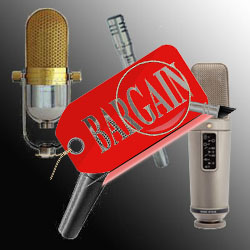 We just started something new to help you keep up with the latest deals on audio recording gear. B&H runs rebate, (instant and mail-in), discount and free shipping deals all the time. We will attempt to make you aware of all the deals as they occur and in time for you to check them out before they expire. Sometimes they only last a few days!
We just started something new to help you keep up with the latest deals on audio recording gear. B&H runs rebate, (instant and mail-in), discount and free shipping deals all the time. We will attempt to make you aware of all the deals as they occur and in time for you to check them out before they expire. Sometimes they only last a few days!
There is a link in bold text across the top of this page that says: Latest Audio Recording Gear Deals. You can click on that link of just Click Here to visit our “Latest Deals” page and save some money on great gear for your home recording studio.
Happy Shopping!
A Mic Preamp for Your iPhone or iPad – IK Multimedia Does it Again
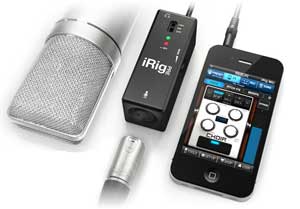
Meet the new iRig PRE from IK Multimedia, a microphone preamplifier (preamp) that works with the iPhone, iPad and iPod Touch. This thing is, as usual from IK Multimedia, awesome. It allows you to plug any microphone (I’ll say that again in case it didn’t sink in…”any microphone”) into your iOS device.
So how is this different from the iRig Mic (see our review of that product here: Review of iRig Mic)? the big difference is, in case you missed it above, that whereas the iRig Mic is a special microphone you get from IK Multimedia that can plug into your iOS device, the iRig PRE is a piece of hardware that allows you to plug any microphone into your iOS device. See the picture to the left. The iRig PRE is the thing in the middle, the little box that has an XLR (standard 3-pin mic connector) female receptacle on one side, and the cord that fits into your iOS device on the other. There is also (and this is ever so cool) a gain control knob/wheel on the iRig PRE.
It uses a 9-volt battery, which also serves as phantom power to condenser mics. The battery life is 40 hours with dynamic mics and 15 hours with condensers.
You can use it with the two free apps iRig Recorder and VocaLive by IK Multimedia. But you should also be able to use it with any app that accepts audio input.
Perhaps the best thing about the iRig Pre is its cost, which is only $39.99. To find out more, or to order your own, Click Here.